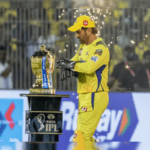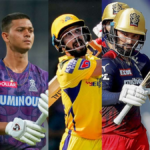The Indian Premier League (IPL) is a high-octane spectacle, a whirlwind of explosive batting, crafty bowling, and athletic fielding. But beneath the dazzling surface lies a complex game of strategy and leadership, orchestrated by the men in blazers – the captains. In this cauldron of pressure and competition, the captain’s role transcends mere playing skills. They become the architects of victories, the navigators through turbulent matches, and the motivators who transform a collection of talented individuals into a cohesive unit.
This article delves into the art of captaincy in the IPL, exploring diverse strategies employed by successful leaders as well as various leadership styles that have brought home trophies. Seize every moment of cricketing action and become King of the IPL with Indibet apk download – your trusted companion for thrilling bets!
Mastering Strategy’s Art
The IPL is a fast-paced format demanding quick decisions and tactical adaptations. What follows is an analysis of captaincy excellence in key strategic areas:
Team Selection & Batting Order: Choosing an XI with careful consideration is crucial. Captains must evaluate pitch conditions, opposition strengths as well as player form to come up with a balanced combination. For example, MS Dhoni was often credited for reading situations astutely; thus he used to change his batting order depending on the required run rate or kind of bowlers operating.
Bowling Attack & Field Placements: Effective bowling plans win matches. With this understanding captains must use their knowledge about strengths and weaknesses and apply them against different batsmen strategically. Field placements play vital roles in restricting runs as well as taking wickets. Also, players like Rohit Sharma are recognized for their innovative fielding arrangements that create points where pressure can be built up so that batsmen can be confused. Why wait? Indibet app download is just a click away. Start winning now!
Captaincy Reads & In-Match Adaptations: The ability to read the game situation and react accordingly is a hallmark of great captains. Understanding when to attack or play cautiously, knowing when to introduce a particular bowler or making crucial DRS calls—these in-match decisions can turn the tide of a contest. However, players like Virat Kohli with an aggressive mindset and constant communication in the field are quick to adjust their strategies depending on how the game progresses.
Leadership Styles for Success
Captains are not created equal. Every leader has a unique style that he/she brings to the table creating a certain team environment. Here are some renowned leadership styles that have proven successful in the IPL:
The Tactician: Leaders like MS Dhoni and Rohit Sharma fall into this category. They rely heavily on proper plans, data analysis as well as calculated decision-making. Specific tasks within this group of leaders are handed to particular players based on their expertise areas and they trust their bowlers to execute precise plans.
The Motivator: Captains like Virat Kohli and Gautam Gambhir embody this style. They lead by example, pushing their teammates to perform at their best because they are passionate about what they do, always making emotional speeches during matches. These captains use aggression as their source of inspiration.
The Diplomat: A more diplomatic form is demonstrated by leaders such as Shreyas Iyer and Kane Williamson. They emphasize the creation of strong team spirit, facilitate communication and create positive environments where all players feel appreciated for whatever contributions they make towards the team’s cause. In addition, they value collective decision-making processes and encourage open communication among members of one team. Do you know – IPL stumps, featuring LED bails, are surprisingly expensive. A IPL stumps price around ₹30-35 lakh, while bails alone can be ₹50,000! The BCCI rents them, not buying them, for around ₹2 crore per IPL season.
Beyond Strategies & Styles: The X-factor
Strategies and leadership styles are important in being a successful captain but there’s something more that makes the difference between good captains and great ones; this is referred to as the x-factor. It could be having exceptional cricketing knowledge, keeping cool under pressure, or making clutch decisions on the fly. Captains like MS Dhoni with his calmness and ability to score last over thrilling victories or Rohit Sharma who can hit quickly and stabilise an opening pair have an added magical touch to their captainship.
The Art of Captaincy: A Learning Curve
The IPL nurtures young talents including future captains. The stewardship of a team in such a highly pressured environment is a learning curve that continues every day. Successful captains keep reworking their strategies, changing leadership styles depending on situations, and learning from past mistakes. Young leaders like Shreyas Iyer and KL Rahul get an opportunity to develop themselves further with the presence of experienced mentors as well as seasoned coaches within the league.
Impact of Captaincy on Team Performance
A strong captain can completely transform a team’s performance. They inject self-assurance into players, build up winning minds and bring out maximum potential from each performer. For instance, Mumbai Indians owe their five IPL titles largely to Rohit Sharma’s leadership abilities. His ability to remain calm during crucial times coupled with accurate tactical moves compels his team members to always perform at optimal levels.
Looking Ahead: The Future of IPL Captaincy
As it evolves further, the IPL fandom will see more importance attributed to captains’ roles. Captains would require incorporating these decision-making tools into their choices when advanced statistics along with data-driven insights come into play. Furthermore, they will also be expected to maintain strong relationships with those in charge of the team to ensure congruence among player selection, team strategies, and long-term objectives amid mounting championship pressures.
The IPL Captain: More Than Just a Player
The IPL captain is more than a mere player. They are not only good at playing cricket, but they also excel as tacticians, motivators and masterminds. They serve as the connection between the team members and managers, represent the franchise and form the motivation behind a team’s success. It is by reacting positively to pressure situations, rising up to changing moments plus instilling confidence in their teams that they become architects of triumphs realized in the fast-paced world of IPL.
For the Fans: Beyond the Game
To fans, understanding what makes up successful captaincy adds another level of excitement to IPL. This way analyzing the captain’s strategic moves, studying his or her leadership style and looking at how it impacts team performance exposes the complexities under which the game operates. Thus, instead of just seeing them score boundaries or take great catches, fans would be interested in learning about what goes behind making a winning performance through strategic thinking and good leadership.
Conclusion
A quick-paced extravaganza is known as the IPL, but there is an intricate game of chess happening underneath which is orchestrated by captains. Their ability to strategize, motivate and adapt are the separating factors that allow their teams to win the trophy. In a continuously developing IPL, captaincy will only become more significant. As such knowledge of captaincy would permit supporters to go beyond mere enjoyment of what happens on the cricket pitch and understand how these captains are in fact ‘the artists’ who have acted tactically or rather demonstrated leadership abilities in IPL.







